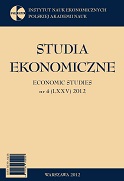Pieniądz niebankowy. Czy istnieje możliwość powrotu?
Non-Bank Money: Is the Return Possible?
Author(s): Andrzej SopoćkoSubject(s): Economy
Published by: Instytut Nauk Ekonomicznych Polskiej Akademii Nauk
Keywords: banking; monetary policy; central bank; economic development; financial equilibrium
Summary/Abstract: Present-day money is issued by the central bank. In its basic form it is a liability on the bank’s balance sheet. This position in turn determines the scale of credits issuance and open market operations. Technically, the issue of money does not have any formal limits – central bank can issue as much money as it wants. This issuance method has its disadvantages. Namely, it is credit money. In the balanced economy the increase of money supply results from rising credit, which is taken when enterprises perceive the good prospects for development. During the crisis they don’t see such possibility. The only chance to cope with the demand shortage is to increase the state expenditures. In the times of M. Keynes such solution was plausible and strongly recommended. Nowadays this remedy seems to be very risky. The indebtedness of the leading economies is too big to increase it further. This suggests a need to consider other forms of money issue. Before modern times money was issued directly by the state (the sovereign). Kings minted coins (not only from gold and silver). Such money reinforced the state budged first, and only later it moved to the private sector, partially returning to the state in the form of taxes. Nowadays only money from taxes reinforces the state budget. It seems not to be the only possible solution. Under some necessary constraints, one should consider coming back to the direct, not credit, form of the budget reinforcement.
Journal: Studia Ekonomiczne
- Issue Year: 2012
- Issue No: 4
- Page Range: 463-482
- Page Count: 20
- Language: Polish

